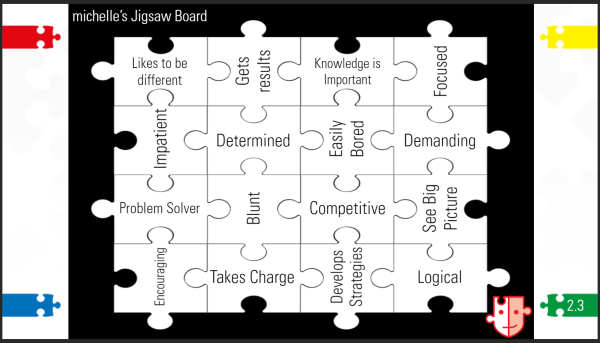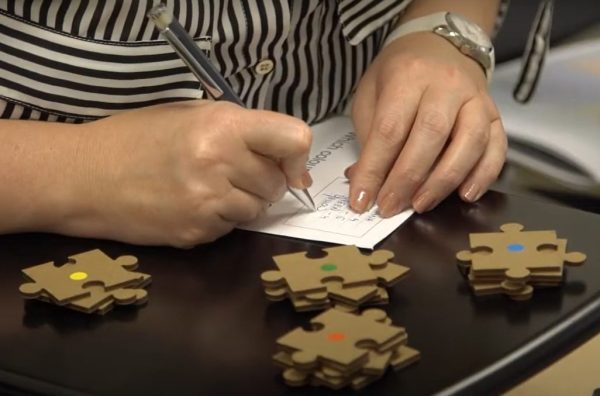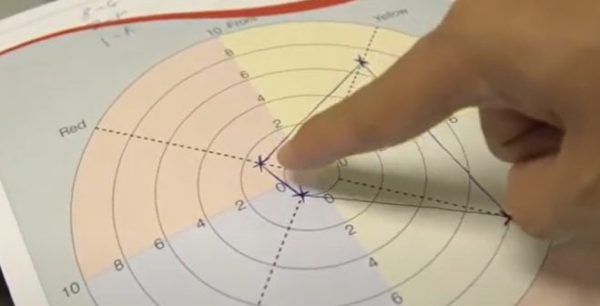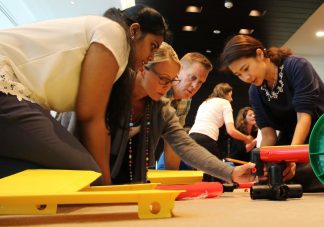Bring the Jigsaw Discovery Tool to life with MTa experiential activities
Part of our series on bringing theories to life with experiential learning. Read the rest here.
Jigsaw Discovery is a behavioural profiling tool that maps a person’s behavioural preferences across four colours.
In this post, we’ll show you how MTa activities can bring the Jigsaw Discovery Tool results to life, by enabling participants to better understand and, where desired, move toward changing their behaviours.
Here’s what we’ll cover:
- A quick intro to the Jigsaw Discovery Tool
- The key differences between the Jigsaw Discovery Tool and other profiling tools
- What your Jigsaw Discovery Tool results mean
- Using MTa materials to bring your Jigsaw Discovery Behavioural Map to life
Readers who are familiar with Jigsaw Discovery can skip to the best MTa activities to build on them.
What is the Jigsaw Discovery Tool?
Jigsaw Discovery is a behavioural profiling tool designed to help participants visualise and better understand their behaviour. The jigsaw imagery is central to understanding the Jigsaw Discovery Tool: each organisation is considered to be a jigsaw, as are the individuals who work there.
By understanding the pieces that make up an individual, and how these individuals fit together to complete the organisational whole, the hope is that people can use a common language to create psychologically safe environments that are conducive to more effective working.
A common language also allows Jigsaw Discovery participants to conceptualise their behaviour and the behaviour of the people around them. Each area of behaviour is attributed to a fictional character, and matched with strengths, potential blindspots, signs of stress, ways to help, and how their behaviour might be perceived by others.
This inward and outward perspective is useful in understanding how behaviour can be leveraged, areas that might need improvement (or external support), how interactions with others can be made more productive, and ways of reducing stress in the workplace.
Let’s take a look at each colour and its associated character:
- Red / Eva Reddy:
- Strengths: Driven, focused, determined, assertive
- Potential blindspots: Impatient, blunt, demanding
- Can be perceived by others as: Bossy, pushy, impatient
- Early signs of stress: Aggressive, impatient
- Ways to help: Offer options, time alone
- Yellow / Ray O’Sunshine:
- Strengths: Resourceful, innovative, problem-solver
- Potential blindspots: Easily bored, attention to detail
- Can be perceived by others as: Disorganised, inconsistent
- Early signs of stress: Argumentative, critical
- Ways to help: Get them involved, offer a time out
- Blue / Mr Huey Blue:
- Strengths: Methodical, factual, disciplined
- Potential blindspots: Feelings and emotions, seeing the big picture
- Can be perceived by others as: Overly critical, pessimistic
- Early signs of stress: Questioning, withdrawn
- Ways to help: Extend deadlines, give more info
- Green / Carey and the Harmonizers:
- Strengths: Team player, considerate, patient
- Potential blindspots: Saying no, being objective, stubborn
- Can be perceived by others as: Indecisive, needy
- Early signs of stress: Judgemental, stubborn
- Ways to help: Show sincerity, show you care
The differences between the Jigsaw Discovery Tool and other profiling tools
Most discovery profiling tools use an evaluator to assess a participant’s personality. This is a series of statements against which a user rates themselves on a spectrum according to which they feel most to least represent them. For example, they may rate “Composed and observant” as a 1 (least like me) but “Open and outgoing” as a 5 (most like me).
After completing all questions in the evaluator, the personality profile is generated and provided as a series of graphs.
The Jigsaw Discovery Tool aims to simplify the process and create a more engaging tool as a result. Instead of filling in statements on an evaluator, participants work through a series of activities to create their behavioural profile.
One of the activities involves creating a 4×4 jigsaw with 16 tiles, each of which features a word they associate with themselves. There are 64 tiles to choose from, giving participants a lot of choice in finding the words that best describe them.

Once the jigsaw is complete, the participant flips it over to reveal the colour on the back of each jigsaw piece. Then they collate how many times each colour appears.


The colours are counted up, then mapped on a chart to provide a visual representation of their behavioural profile. Once the profiles are completed, the facilitator moves onto explain what each colour preference represents, and the qualities of the characters associated with each.
Attaching the profile to the behaviours and interaction styles of fictionalised characters is a reliable way of increasing participant engagement and understanding. It is easier to identify with human characters than abstract concepts, and because the characters are fictionalised, potentially negative aspects or manifestations of their behaviour can be discussed without hurting the feelings of anyone in the room.
Taking the learning further
Completing the Jigsaw Discovery Behavioural Profile gives participants a deeper understanding of several things:
- Their behavioural style
- The strengths associated with their behavioural style
- The potential blindspots of their behavioural style
- How their behavioural style may be perceived by others
- Early and advanced signs that they are becoming stressed
- Ways to help them in the workplace
Information on each of these points provides a strong and fertile bedrock on which to further explore and ideally refine areas of behaviour. The Jigsaw Discovery Tool provides this bedrock, and experiential learning activities are an effective way of building upon it.
Using MTa materials to bring the Jigsaw Discovery Learning to life
All MTa kits contain experiential learning activities designed to simulate situations that might arise in the workplace, where participants’ behaviours can be observed, considered, and discussed in a controlled environment, free of the pressures and consequences you’d find in the real world.
For individuals who have just completed their Jigsaw Discovery profile, here are a handful of experiential learning activities that will allow them to:
- See real-world examples of how their behaviour manifests
- Engage in constructive discussions about how their behaviour is perceived
- Harness the strengths associated with their behaviour
- Identify and minimise the impact of the blindspots
- Give and receive help according to their own and others’ behavioural styles
Below you’ll find four MTa activities that work particularly well alongside the Jigsaw Discovery Tool.
Culprit
This activity gives participants the opportunity to learn more about:
- How others perceive their personal impact in teams
- How to give and receive feedback based on behaviour
- How to change their personal approach while improving their impact
These outcomes align very well with the Jigsaw Discovery Tool. Participants will be freshly aware of their behaviour profile, meaning that hearing from team mates how their behaviours manifest and impact the outcome of the activity will be especially instructive.
An opportunity to change their approach and see the immediate impact of these changes on the outcome also provides a controlled context for behavioural change: something that can be difficult to do in the workplace.
The Culprit is available as an online activity through MTa Immersion, or as a standalone kit.
Swinging, Communications from MTa Insights
This activity has primary learning outcomes that align with some of the character traits from the Jigsaw Discovery Tool. Participants will be able to see and understand how their own character traits manifest, as well as how their teammates’ character traits.
Some of these learning outcomes include:
- Expressing yourself clearly: Strength for blue, potential blindspot for yellow
- Effective communication: Strength for blue, potential blindspot for yellow
- Concern for others: Strength for green, potential blindspot for red
- Explaining versus instructing: Strength for red, potential blindspot for green
Swinging is part of MTa Insights.
New Dimensions
MTa New Dimensions is designed to break down silos, improve relationships, and foster effective communication between people and within teams. It’s a great activity for putting Jigsaw Discovery Tool learnings into practice, letting participants observe their theoretical knowledge as tangible behaviours.
There are three stages to New Dimensions:
- Establish priorities and challenge assumptions
- Inter-team cooperation
- Collaborating to add value
Each setting is different and invites its own type of communication, meaning participants have the chance to use varied approaches. The context of the game means they can either observe their natural behaviours or try new behaviours in a controlled setting.
This activity is available as a standalone kit, here.
The Tower, Team Kit
Part of the language around the Jigsaw Discovery Tool involves perceiving the individual as a jigsaw, but this is true at an organisational level as well. The Tower is great for showing how character traits and behaviours have an impact on team performance, and on the bigger picture.
To succeed in The Tower, participants must work effectively within their team, and teams must work effectively with each other. By sharing resources, communicating effectively, and trusting each other, all teams are able to improve their performance.
The Tower works well at the end of a development program, making it a good choice to use after completing and discussing the Jigsaw Discovery Tool, and potentially running another couple of activities.
Learning opportunities for The Tower include:
- Building and maintaining trust
- Working with others to maximise your performance (towards win/win)
- Delegating tasks within teams
- Company versus departmental objectives
- Inter-team communications
The Tower is part of the MTa Team Kit.
Let us help you
The Jigsaw Discovery tool is a popular and engaging tool, and with the right experiential learning activities, it can form the basis of an individual’s overhauled understanding of their behaviour.
In this blog we’ve looked at four experiential learning activities that work in lockstep with the Jigsaw Discovery Tool. If you’d like to learn more about how our kits and activities can help your business to achieve its goals, book a call with Jamie to discuss your needs.

